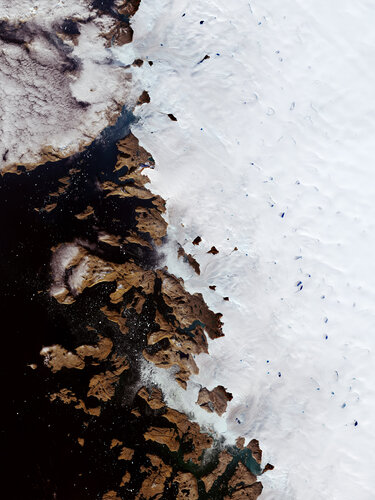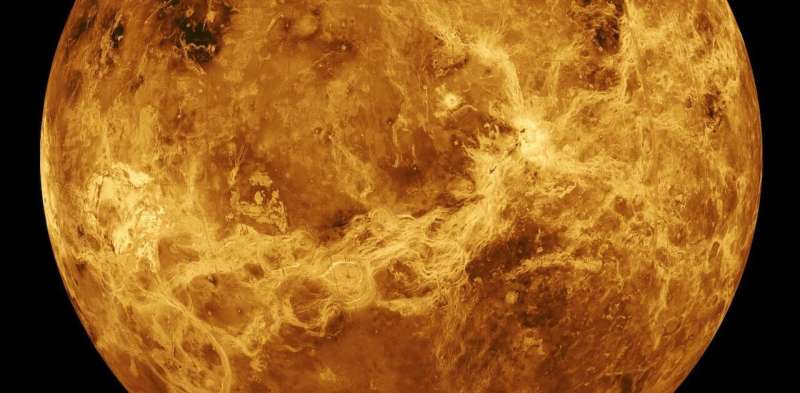
Copernical Team
Week in images: 26-30 September 2022

Week in images: 26-30 September 2022
Discover our week through the lens
Venus: The trouble with sending people there

Venus, often called Earth's "evil twin" planet, formed closer to the sun and has since evolved quite differently from our own planet. It has a "runaway" greenhouse effect (meaning heat is completely trapped), a thick carbon-dioxide-rich atmosphere, no magnetic field and a surface hot enough to melt lead.
Several uncrewed scientific missions will study how and why that happened in the next decade. But now some scientists want to send a crewed mission there as well for a flyby. Is that a good idea?
With a slightly smaller diameter than Earth, Venus orbits closer to the sun. This means that any water on the surface would have evaporated shortly after its formation, starting its greenhouse effect. Early and sustained volcanic eruptions created lava plains and increased the carbon dioxide in the atmosphere—starting the runaway greenhouse effect, which increased the temperature from just a little higher than Earth's to its current high value of 475°C.
While the Venus year is shorter than ours (225 days), its rotation is very slow (243 days) and "retrograde"—the other way round to Earth. The slow rotation is related to a lack of magnetic field, resulting in a continuing loss of atmosphere.
Europe’s space industry gathers at ESA

ESA welcomed a record 1700 visitors from 800 companies and institutions to its Industry Space Days event on 28–29 September at ESTEC, its technical centre in The Netherlands. It is a place where industry can meet and share their ideas for new emerging uses of space and commercial potential.
New rocket company fails to achieve launch on 2nd attempt
A year after its first rocket launch failed, a new aerospace company was unsuccessful early Friday in its second attempt to place multiple satellites into orbit.
Firefly Aerospace's Alpha rocket was unable to lift off from Vandenberg Space Force Base, California, and follow a planned arc over the Pacific Ocean toward space.
A live video feed showed the launch countdown go to zero and then abort at 12:52 a.m. Friday.
"The vehicle went into auto abort after ignition. This is designed into the system to ensure safety," the company said in a Twitter post. "The team scrubbed tonight's launch attempt and is reviewing data to determine our next launch window."
The rocket's payload included multiple small satellites designed for a variety of technology experiments and demonstrations as well as educational purposes.
The mission, dubbed "To The Black," was the company's second demonstration flight of its entry into the market for small satellite launchers.
The first Alpha was launched from Vandenberg on Sept. 2, 2021, but did not reach orbit.
One of the four first-stage engines shut down prematurely but the rocket continued upward on three engines into the supersonic realm where it tumbled out of control.
The rocket was then intentionally destroyed by an explosive flight termination system.
ESA selects Harmony as 10th Explorer mission
 Following preparatory activities and a stringent process ESA Member States today formally selected Harmony for implementation as the tenth Earth Explorer mission within the FutureEO programme. This unique satellite mission concept is, therefore, now set to become a reality to provide a wealth of new information about our oceans, ice, earthquakes and volcanoes - which will make significant contri
Following preparatory activities and a stringent process ESA Member States today formally selected Harmony for implementation as the tenth Earth Explorer mission within the FutureEO programme. This unique satellite mission concept is, therefore, now set to become a reality to provide a wealth of new information about our oceans, ice, earthquakes and volcanoes - which will make significant contri HawkEye 360 adds new radar and communication signals to RFGeo
 HawkEye 360 Inc., the world's leading commercial provider of space-based radio frequency (RF) data and analytics, has announced two new signals available as part of its RFGeo signal mapping product: VHF and UHF Flex. RFGeo data and analytics provide a new geospatial data layer that enables RF awareness, utilizing the unique data generated by HawkEye 360's satellite constellation to detect and ge
HawkEye 360 Inc., the world's leading commercial provider of space-based radio frequency (RF) data and analytics, has announced two new signals available as part of its RFGeo signal mapping product: VHF and UHF Flex. RFGeo data and analytics provide a new geospatial data layer that enables RF awareness, utilizing the unique data generated by HawkEye 360's satellite constellation to detect and ge New measurement of stellar neutron source reaction resolves long-standing discrepancies
 The Jinping Underground Nuclear Astrophysics (JUNA) collaboration has reported a recent direct measurement of the cross section of a crucial stellar neutron source reaction, 13C(a,n)16O. The study was published in Physical Review Letters on September 23.
By achieving the most accurate cross sectional measurement of this reaction at astrophysical energies so far, the study has resolved long
The Jinping Underground Nuclear Astrophysics (JUNA) collaboration has reported a recent direct measurement of the cross section of a crucial stellar neutron source reaction, 13C(a,n)16O. The study was published in Physical Review Letters on September 23.
By achieving the most accurate cross sectional measurement of this reaction at astrophysical energies so far, the study has resolved long Synthetic lava in the lab aids exoplanet exploration
 The exploration era for the new James Webb Space Telescope (JWST) is getting hot - volcanically hot. A multidisciplinary group of Cornell researchers has modeled and synthesized lava in the laboratory as the kinds of rock that may form on far-away exoplanets. They developed 16 types of surface compositions as a starter catalog for finding volcanic worlds that feature fiery landscapes and oceans
The exploration era for the new James Webb Space Telescope (JWST) is getting hot - volcanically hot. A multidisciplinary group of Cornell researchers has modeled and synthesized lava in the laboratory as the kinds of rock that may form on far-away exoplanets. They developed 16 types of surface compositions as a starter catalog for finding volcanic worlds that feature fiery landscapes and oceans Lunar glass shows Moon asteroid impacts mirrored on Earth
 A Curtin-led research team has found asteroid impacts on the Moon millions of years ago coincided precisely with some of the largest meteorite impacts on Earth, such as the one that wiped out the dinosaurs.
The study also found that major impact events on Earth were not stand-alone events, but were accompanied by a series of smaller impacts, shedding new light on asteroid dynamics in the i
A Curtin-led research team has found asteroid impacts on the Moon millions of years ago coincided precisely with some of the largest meteorite impacts on Earth, such as the one that wiped out the dinosaurs.
The study also found that major impact events on Earth were not stand-alone events, but were accompanied by a series of smaller impacts, shedding new light on asteroid dynamics in the i China's Mars rover reveals more of subsurface
 What does the subsurface of Mars' northern lowlands have in common with a French mille crepe cake? They both consist of a number of layers, according to the latest findings by China's Zhurong Mars rover published in the journal Nature on Monday.
The discovery showed that the evolution of the Martian surface environment is more varied and complex than previously anticipated, experts said. L
What does the subsurface of Mars' northern lowlands have in common with a French mille crepe cake? They both consist of a number of layers, according to the latest findings by China's Zhurong Mars rover published in the journal Nature on Monday.
The discovery showed that the evolution of the Martian surface environment is more varied and complex than previously anticipated, experts said. L 
